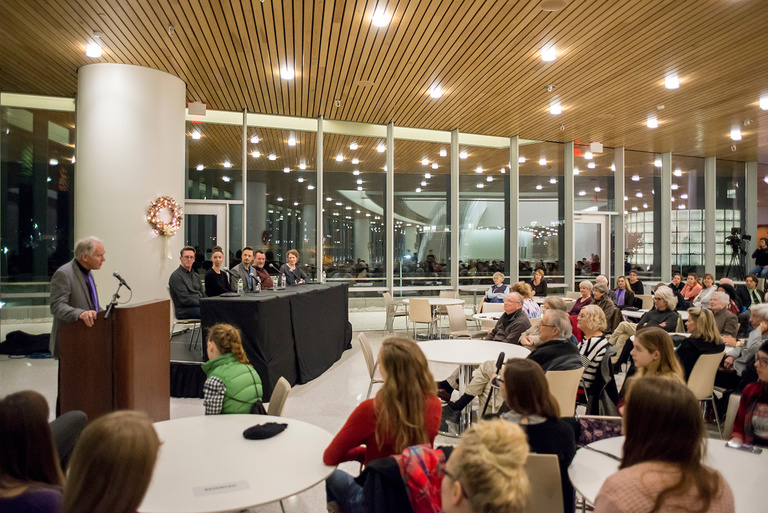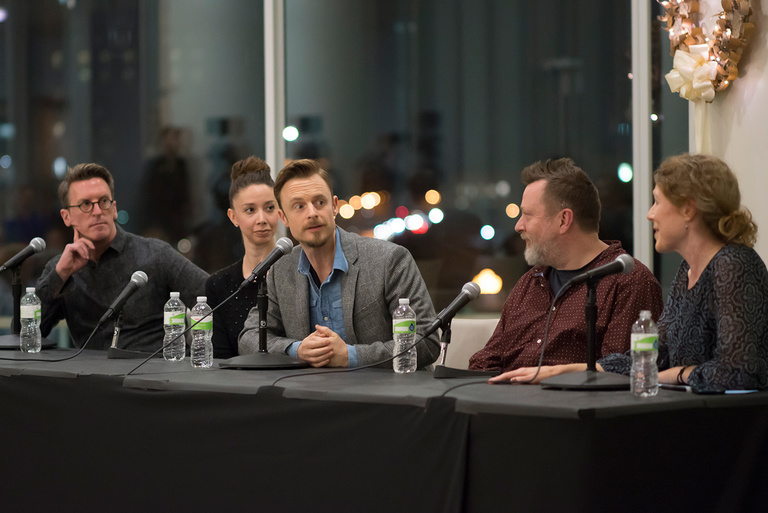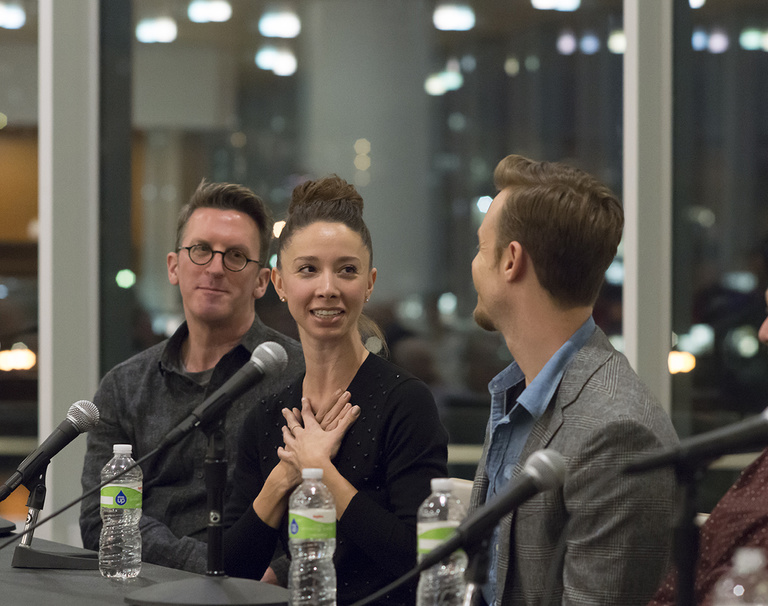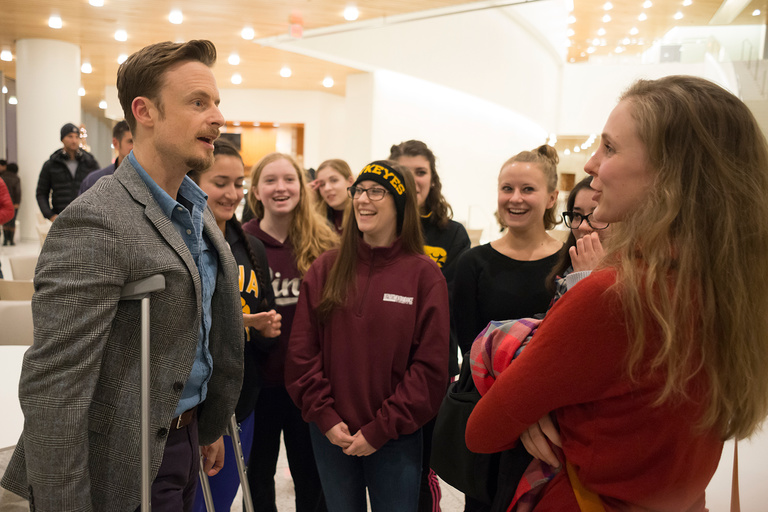
Wheeldon and a portion of the Joffrey Nutcracker artistic team–Julian Crouch, set, costume, mask designer; Ashley Wheater, Joffrey artistic director; and April Daly, Joffrey dancer–gathered to discuss the creative process of reimagining the classic Nutcracker ballet in a cozy corner of the Stanley Café at Hancher ahead of preview performances, Dec. 1-4.
The Nutcracker is a ballet so set in its ways that, as panel moderator and journalist Rebecca Ritzel pointed out, typically “the major difference between Nutcrackers is some people spell ‘Sugarplum’ as one word, others as two.”
However, the new Joffrey Nutcracker will have neither Sugarplum nor Sugar Plum Fairy. There is a dragon but no Russian dancers. Rather than in an opulent Victorian home, the ballet is set in a poor immigrant community in Chicago tasked with constructing the 1893 World’s Fair.
Thus Ritzel started the panel discussion asking, is nothing sacred?

The storytelling in this version of the Nutcracker, Wheeldon said, is focused on a community and family who, with very little in the way of wealth or possessions, create magic under the direction of a character called the Great Impresario. This showman comes to worker huts on Christmas Eve to reward them for building Chicago’s magnificent fairground. Clara is replaced by Marie–a child whose father is absent for reasons not explained.
“That’s probably the largest invention,” said Wheeldon. “It’s not about a wealthy Victorian child who grows up and has this privileged lifestyle, a wonderful Christmas Eve party, and she falls asleep and dreams of more goodies. This is a child who is missing something very important to her–missing a parent who is a member of this community. She is rewarded at the end of this journey by more than just candy–let’s leave it at that for now.”
The Joffrey Ballet has a long enduring relationship with the University of Iowa. The last time the Joffrey Ballet created a new Nutcracker was 29 years ago. It was choreographed by Robert Joffrey and danced by Wheater, and also previewed at Hancher. While much beloved, Wheater said the first Joffrey Nutcracker was long overdue for retirement; costumes were in tatters, wooden scenery was rotting, and he wanted to seize the opportunity to work with “one of the best living, breathing choreographers in the world today” to create a new Nutcracker designed specifically for the people of Chicago.

Wheeldon compared creating a new artistic expression of the Nutcracker with a group of collaborators, including puppeteer (and recent Creative Matters speaker) Basil Twist and children’s book writer and illustrator Brian Selznick, to what it must have been like to orchestrate the 1893 Chicago World’s Fair itself. Creatively the team is working within two constraints: Tchaikovsky’s musical score and the historical event represented by the 1893 World’s Fair.
For the sets, costumes and mask designs, Crouch described working through mountains of research and photographs highlighting the iconic images of the 1893 World’s Fair: the first Ferris Wheel, the centuries old California palm tree transplanted to the fair, and The Statue of the Republic, wrapped in gold leaf and, at the time, the second tallest statue in the world after the Statue of Liberty.
“Whenever you do something that involves realism and historical research, you kind of have to find where that meets theatricality and fantasy,” said Crouch. “I suppose the process then is weighing up this research with what you dream of doing.”
The panel also offered insight into the choreography process working with the ballet dancers themselves such as molding complicated steps, body lines and positions on the gifts and abilities of the Joffrey principle dancers. And teasers about the big reveal in the story.

Three weeks prior to the opening night, all the pieces of the performance were coming together for the first time: the scenery, the costumes, the lighting, and the results of months of hard work by the Joffrey dancers and the Iowa City-area child dancers participating in the preview performances.
“When you’re spending millions of dollars on a new production, and it’s so complicated, time for us is the most valuable thing in the world,” said Wheater. “Having these three weeks here at Hancher to really get this production together has been phenomenal. I just want to say, on behalf of the Joffrey Ballet, to Hancher and the University of Iowa for believing in the Joffrey, supporting us, and giving us time–thank you.”
“I’m hoping this production lasts another 29 years,” he said.
“Let’s shoot for 30,” said Wheeldon.
To watch the full lecture, please visit: https://www.youtube.com/watch?v=M1VKzOksLyg&feature=youtu.be
For a full listing of other events in the 2016-17 Creative Matters lecture series, please visit https://creativematters.research.uiowa.edu/.
The Creative Matters lecture series seeks to demonstrate that creativity is not only at the core of all research and discovery, but is also central to our human experience. The lineup of invited speakers includes artists, thinkers, builders, and doers who challenge conventional thinking about creativity, science, and artistic expression, borrowing from a range of influences and disciplines in their work.
The Office of the Vice President for Research and Economic Development provides resources and support to researchers and scholars at the University of Iowa and to businesses across Iowa with the goal of forging new frontiers of discovery and innovation and promoting a culture of creativity that benefits the campus, the state, and the world. More at http://research.uiowa.edu, and on Twitter: @DaretoDiscover.
Photos: (top) Chuck Swanson, executive director of Hancher, introduces Nutcracker panel participants.
(second) From left-to-right, Ashley Wheater, Joffrey artistic director; April Daly, Joffrey dancer; Christopher Wheeldon, choreographer; Julian Crouch, set, costume, mask designer; and panel moderator and journalist Rebecca Ritzel.
(third) Joffrey dancer April Daly, second from left, describing her experience working with choreographer Christopher Wheeldon, third from left. Ashley Wheater (far left) Joffrey artistic director and Julian Crouch (far right) look on.
(bottom) Christopher Wheeldon chats with University of Iowa students.
Credit: Michael Stenerson